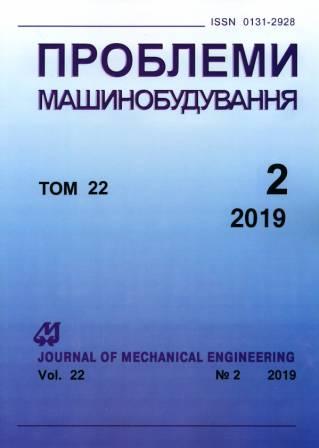Розрахунок показників надійності технічних систем методом типових структурних схем
Ключові слова:
алгоритм, система, структурна надійність, типові схемиАнотація
Наведено метод, розроблений для розрахунків показників структурної надійності систем з великим числом елементів. Метод ґрунтується на використанні типових структурних схем, що відбивають принципову схему зв'язків між елементами. Показано, як шляхом поповнення та об'єднання типових структур можна створювати графологічні структури для виконання розрахунків показників надійності. Підхід може бути використаний під час розробки алгоритмів і програм розв’язання на ЕОМ задач, що базуються на оцінках структурної надійності систем. До числа таких задач, зокрема, належать: оцінки безпеки атомних блоків, планування їх ремонтів, оцінки надійності спрямованих систем транспортування середовищ, оцінки залишкових ресурсів технічних об'єктів. Для їх розв’язання розроблені різні окремі методи. Однак стандартизувати розрахунки показників надійності неможливо через різноманітність систем і умов їхнього функціонування. Поданий підхід орієнтований на автоматизацію розрахунків показників структурної надійності широкого класу технічних систем. Він базується на доказі існування алгоритму розрахунку на множині типових структурних схем. Водночас передбачається, що на ЕОМ розпізнавані образи типових структур в складі графологічних образів систем. Зміст задачі полягає в такому. Є технічна система. Потрібно побудувати графологічний образ і розрахувати показник її структурної надійності. Метод розрахунку, що пропонується, ґрунтується на зображенні графологічного образу системи у вигляді композиції графологічних образів типових структур, показники надійності яких обчислювальні. Вони замінюються окремими елементами з обчисленими значеннями показника надійності. Заміни дають можливість спростити початковий графологічний образ системи за рахунок скорочення загального числа елементів і обчислити показник надійності системи. Процедура обчислення і заміни триває доти, поки в графологічному образі системи не залишиться одна типова структура, для якої показник надійності обчислювальний. Кількість елементів в системі нічим не обмежена, оскільки процедура замін здійснюється послідовно до створення однієї типової структури. Істотне обмеження в застосуванні методу до розрахунку структурної надійності широкого спектра складних технічних систем обумовлено обмеженістю множини типових структур. Однак такий банк типових структур може бути створений і використовуватися під час розробки відповідних розрахункових програм.Посилання
Ostreykovskiy, V. A. (2003). Teoriya nadezhnosti [Reliability Theory].Moscow: Vysshaya shkola, 463 p. (in Russian).
Guk, Yu. B. (1988). Analiz nadozhnosti elektroenergeticheskikh ustanovok [Analysis of the reliability of electric power plants].Leningrad: Energoatomizdat, 224 p. (in Russian).
Nitushin, V. G. (1984). Nadezhnost energeticheskikh sistem [Reliability of energy systems].Moscow: Vysshaya shkola, 256 p. (in Russian).
Ryabinin, I.A. & Cherkesov G. N. (1981). Logiko-veroyatnostnyye metody issledovaniya nadezhnosti strukturno-slozhnykh sistem [Logic-probabilistic methods for studying the reliability of structurally complex systems].Moscow: Radio i svyaz, 264 p. (in Russian).
Cherkesov, G. N. (1980). Analiz nadozhnosti slozhnykh sistem pri pomoshchi veroyatnostnoy logiki [Analysis of the reliability of complex systems using probabilistic logic]. Osnovnyye voprosy teorii i praktiki nadozhnosti – The main issues of the theory and practice of reliability, Collection of Works of the Scientific Council Seminar on Problems of Reliability of the Department of Mechanics and Control Processes of the USSR Academy of Sciences.Moscow: Sovetskoye radio, 328 p. (in Russian).
Polovko, A. M. & Gurov, S. V. (2006). Osnovy teorii nadezhnosti [Basics of reliability theory].St. Petersburg: BKHV-Peterburg, 704 p. (in Russian).
Venttsel, Ye. S. (1972). Issledovaniye operatsiy [Operations research].Moscow: Sovetskoye radio, 550 p. (in Russian).
Zevin, L. I., Inkulis, V. V., & Zevin S. L. (2002). Metodika rascheta i analiza strukturnoy nadezhnosti blokov atomnykh stantsiy [Method of calculating and analyzing the structural reliability of nuclear power units]. Problemy mashinostroyeniya – Journal of Mechanical Engineering, vol. 5, no. 2, pp. 34–37 (in Russian).
Zevin, S. L. (2002). Raspoznavaniye strukturnykh skhem v zadachakh modelirovaniya nadezhnosti energoustanovok [Recognition of structural diagrams in problems of modeling the reliability of power plants]. Visnyk NTU «KhPI». Seriya: Elektroenergetika i preobrazovatel'naya tekhnika – Bulletin of the NTU "KhPI". Series: Power and converter technology, iss. 9, vol. 3, pp. 33–38 (in Russian).
Oboskalov, V. P. (2015). Problemy rascheta strukturnoy nadezhnosti sistem elektrosnabzheniya s ispol'zovaniyem metoda veroyatnostnogo ekvivalentirovaniya [Problems of calculating the structural reliability of power supply systems, using the probabilistic equivalent method]. Elektrichestvo – Electricity, no. 12, pp. 4–12 (in Russian).
Burmutayev, A. Ye. (2011). Slozhnost modelirovaniya intervalnykh otsenok pokazateley strukturnoy nadezhnosti elektrotekhnicheskikh kompleksov metodom Monte-Karlo [The complexity of modeling interval estimates of the indicators of structural reliability of electrical systems, using the Monte-Carlo method]. Vektor nauki Tolyattin. gos. un-ta – Vector of Science of Togliatti State University, no. 3 (17), pp. 72–75 (in Russian).
##submission.downloads##
Опубліковано
Номер
Розділ
Ліцензія
Авторське право (c) 2019 Leonid I. Zevin, Hennadii H. Krol

Ця робота ліцензується відповідно до Creative Commons Attribution-NoDerivatives 4.0 International License.
Автори, які публікуються в цьому журналі, погоджуються з наступними умовами:
- Автори залишають за собою право на авторство своєї роботи і передають журналу право першої публікації цієї роботи на умовах ліцензійного договору (угоди).
- Автори мають право самостійно укладати додаткові договори (угоди) з неексклюзивного поширення роботи в тому вигляді, в якому вона була опублікована цим журналом (наприклад, розміщувати роботу в електронному сховищі установи або публікувати в складі монографії), за умови збереження посилання на першу публікацію роботи в цьому журналі.
- Політика журналу дозволяє розміщення авторами в мережі Інтернет (наприклад, у сховищах установи або на персональних веб-сайтах) рукопису роботи як до подачі цього рукопису в редакцію, так і під час її редакційної обробки, оскільки це сприяє виникненню продуктивної наукової дискусії і позитивно позначається на оперативності та динаміці цитування опублікованої роботи (див. The Effect of Open Access).

